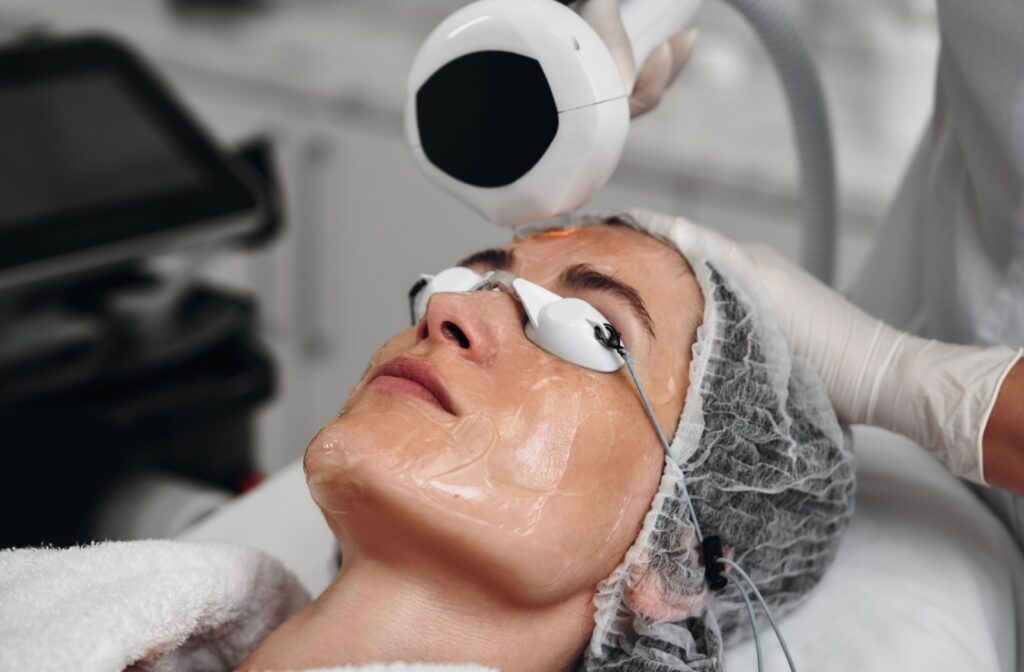Life in Calgary can be wonderful. Seeing the outline of the Rockies on your commute or dazzling sunny days year-round is worth it. What doesn’t feel amazing, however, is how dry this city is. If you deal with persistent dry eye symptoms, you know all too well how challenging living in a dry climate can be.
More than pesky irritation, moderate to severe dry eye can cause blurry vision, discomfort, and even affect your overall quality of life. Solutions like artificial tears and warm compress masks and eye lid massage can all help, but don’t tackle the problem’s root cause.
Enter IPL or intense pulsed light therapy, a modern treatment that transforms dry eye management.
This noninvasive device uses controlled light pulses to stimulate oil glands that line the eyelids to improve tear stability by tackling one of dry eyes’ underlying causes: meibomian gland dysfunction (MGD).
What Is Meibomian Gland Dysfunction?
To truly appreciate how IPL effectively treats dry eye, we need to take a closer look at meibomian gland dysfunction (MGD).
Meibomian glands are tiny oil-producing glands that line your eyelids. Their main job is to produce and secrete oils into your tears. This oil forms the outermost layer of your tear film and is responsible for preventing tear evaporation.
When these glands become clogged or inefficient, this leads to an unhealthy tear film. Without enough oil, your tears can evaporate too quickly, leading to dry, irritated, and scratchy eyes. This condition, known as MGD, is the primary culprit behind many dry eye cases.
Spending long hours on digital screens or living in dry, windy, or smoky environments can also contribute to dry eyes, exacerbating symptoms such as redness, foreign body sensation or watery eyes. Solutions like artificial tears or heat masks can offer temporary relief, but don’t address the underlying cause of MGD.
This is part of what makes IPL a possible game-changer for dry eye management.
The Science Behind IPL Therapy
The aesthetic world is well aware of intense pulsed light (IPL) therapy for treating skin conditions such as rosacea and sun spots. However, its application in vision care offers a breakthrough for those with dry eyes.
IPL technology can be particularly helpful for reducing inflammation around the eyelids that stems from MGD. It uses controlled light energy to gently target the skin’s surface and deep layers, helping your eyes stay moist throughout the day.
- Minimizing Demodex mite activity: Demodex mites are tiny organisms that can live in and around your eyelids, exacerbating inflammation and clogging your tear glands. IPL can help reduce their presence.
- Restoring meibomian gland function: The heat from IPL warms and unclogs the glands, allowing them to secrete oil more effectively. This helps restore balance to the tear film.
- Reducing redness and swelling: IPL’s anti-inflammatory properties help improve overall eyelid health for better eye comfort.
This comprehensive approach makes IPL therapy effective for people with MGD-driven dry eye.
The IPL Treatment Process Explained
IPL is a quick and noninvasive treatment. This means little to no downtime after your session, so you’re free to go about your daily routine. With that said, new experiences can always be a little nerve-wracking, but there’s truly nothing to worry about!
We’re here to make this entire process comfortable. Knowing what to expect with your treatment can help you feel more prepared. Here’s what you need to know:
Consultation
The journey to IPL starts with an initial consultation where we evaluate your eye health and the severity of dry eye to determine if this treatment is right for you. This also helps us create a custom treatment plan that aligns with you.
In the days leading up to your treatment, please remember to:
- Avoid direct sun exposure and wear sunscreen prior to and during the treatment interval.
- Drink plenty of water to keep your skin hydrated and healthy.
- Stop using retinoids, glycolic acid, and other harsh exfoliants for about a month prior to your session.
- Do not wax, pluck, or use hair removal creams on the treatment area within 2 weeks of your session.
- Avoid using self-tanners or spray tans for at least 2 weeks before your IPL session.
- Advise your ophthalmologist of any new medications you are taking, such as antibiotics or oral retinoids; in some cases we may need to delay treatment.
Taking these measures helps set the foundation for a safe and successful IPL experience.
Preparation
On the day of your session, please arrive with clean skin, free of makeup, lotion, or sunscreen. Bare skin is ideal, as it facilitates better results. If you forget, that’s okay! You can always cleanse your skin at our clinic.
Once your skin is ready, we will give you protective eye goggles to shield your eyes from the flashes of light the device emits. We also apply a cooling gel to the treatment area (usually around the lower eyelids).

Application
The entire process for one IPL session typically takes about 45-60 minutes.
Your practitioner uses the IPL device to deliver pulses of light to the skin surrounding the eyes, melting any blockages from meibomian glands. The flashes are brief and targeted, lasting only a fraction of a second.
Next, to thoroughly clear any debris, we manually express the meibomian glands. This entire process helps restore gland function and improve tear stability, allowing your eyes to stay moist throughout the day.
It’s a relaxing and soothing treatment. Think of IPL as a spa treatment for your eyes, full of benefits that support your long-term visual health and comfort.
After Your Session
Some may experience noticeable relief after their first session, but the full benefits kick in after multiple treatments. Significant, sustained improvements typically require about 3–4 sessions spaced a few weeks apart.
It’s normal to experience minor redness or a warming sensation around the treatment area, but this should subside within a few hours.
It’s worth highlighting that IPL alone is not a permanent solution for dry eyes. Given the conditions’ chronic nature, we can manage (not cure) dry eye symptoms for lasting relief.
Once the glands are open and functioning, you can maintain the results of your sessions at home with artificial tears, warm compress masks, and lid massages. Remember to blink regularly and fully, and take breaks from digital screens.
By the end of your series of treatments (and following eye-healthy habits at home), you can expect healthier glands, improved tear quality, and relief from chronic dry eye symptoms and confidence that you have prevented further meibomian gland loss.
Healthier, Happier Eyes Are Ahead
IPL treatment is changing how we manage dry eye symptoms, particularly for those with meibomian gland dysfunction. Its safe, targeted approach offers a much-needed solution for people struggling with chronic discomfort and irritation.
If you’re considering IPL, the road to healthier eyes starts with a consultation. At Vector Eye Centre, our team is here to guide you every step of the way.
Whether you’re curious about your first session or want to understand how many treatments you may need, we’re ready to answer all your questions.
Take the first step towards clear, comfortable eyes. Connect with our team today to book your consultation.



